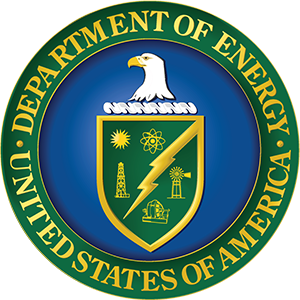Introduction
Within This Page
Information technology (IT) engineers deal with the design and integration of multiple systems of structured cable and wireless information technologies relating to buildings and building occupants:
- Building systems—HVAC, lighting, daylighting control, energy monitoring, security access, and fire/smoke detection and alarm.
- Telecommunications—voice, data, graphics, and audiovideo.
Several developments which occurred somewhat simultaneously in the early 1980s drove the explosive growth of information technology—the divestiture of the Bell corporate empire, the Internet, the personal computer, user friendly software interfaces, and large capacity investments in telecommunications infrastructure, satellites, and fiber optic cable systems.
The emerging development of building information modeling (BIM) has the potential to integrate the design, fabrication, construction, and O&M databases over the life cycle of the building development.
Description
Integrated Design
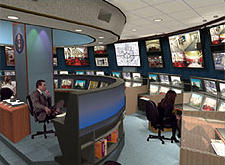
Concept of a Security Command Center that integrates multiple technologies seamlessly into one facility
Such systems as telecommunications, data, building operation controls, audiovisual, and security are commonly introduced as separately operating systems. Integrated building systems now have the capability to use the same structured cable network and enable interoperability across all systems. The IT Engineer designs the structured cable system network that enables the user's technology systems and the building operating systems to function in an integrated manner.
Synergies enabling user comfort and building energy savings can be realized when integrated systems can interact seamlessly, thus benefiting the comfort and business needs of the user and the building owner simultaneously.
This is most easily accomplished when all building stakeholders and members of the design team are brought as early as possible into the integrated design process. The IT Engineer should be involved with design decisions from project start since IT design overlaps and affects building operations systems, vertical and horizontal space utilization, and user/organizational business needs.
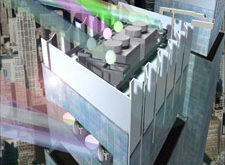
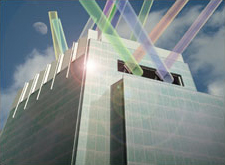
The rooftop concept designed by IT Engineers to provide the developer with an IT-based revenue stream—one part of a four-part IT business model for the building. The developer can lease this equipment/space to cellular providers and broadcasters.
Integration of IT technology requirements into building façade and rooftop design.
Design Objectives
Information systems will affect all design objectives of the complex modern commercial, institutional, or governmental building:
- Accessible for physically challenged user access to telecommunications and security devices
- Cost-Effective for initial construction cost and user life-cycle cost
- Functional/Operational for integrated control of building operational systems and building automated systems (BAS)
- Productive for user health and comfort, and business/organization needs
- Secure/Safe for building security access, surveillance, fire/smoke detection and alarm systems; and user LAN/WAN network security
- Sustainable—Enhance Indoor Environmental Quality; Optimize O&M Practices for high performance optimization of building controls and operational systems
- The design and implementation of wiring and cabling systems has direct impact on aesthetics and preserving historic spaces within the building.
As advanced electronic entertainment systems, home offices, and telecommuting become more prevalent, multi-unit and single-unit residential buildings are being built and marketed to attract the IT-sophisticated residential consumer.
Flexibility
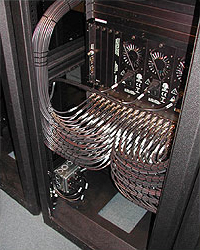
Scalable IT infrastructure will accommodate future technologies
All organizations must be adaptable to a high rate of change. IT is one of the most rapidly changing aspects of technologically advanced societies across the globe. New devices and technologies for business and personal use are constantly being brought to market. As new IT technologies are introduced, building and IT infrastructure design must be flexible and adaptable to accommodate future new technologies so as not to disrupt ongoing business operations or cause excessively costly modifications to existing systems.
Design for IT flexibility requires consideration of all or some of the following:
- Adequate power for future building/system expansion including emergency power supply
- Adaptable power and telecommunication cores
- Adaptable dedicated electrical and telecommunications spaces
- HVAC delivery to dedicated IT spaces
- Network security
- Strategically located branch takeoffs and utility stubs
- Adaptable plenum systems—either overhead or underfloor, coordinated with space needs for parallel HVAC, power, lighting, and fire protection systems as applicable
- Overhead exposed cable trays integrated with parallel HVAC, power, lighting, and fire protection systems
Emerging Issues
Integrated Practice
The building industry has been focused on rapidly emerging technologies in building information modeling and interoperability that will radically change the process of design, fabrication, construction, and maintenance of buildings over their life cycle. These same technologies threaten to change traditional industry business and contractual relationships regarding inefficiencies due to design and construction industry fragmentation; risk distribution and ownership of design information; compensation methodology—value based vs. cost based fee determination; leveraging of project information knowledge early in the design process; and intellectual property compensation for knowledge stored in an A/E BIM to be modified by input of project-specific data.
The American Institute of Architects (AIA) has recently announced the establishment of the Integrated Practice Strategy Working Group (IPSWG), which brings AIA knowledge communities and committees together to discuss this potential redefinition of architectural practice.
Building Information Modeling (BIM)
Building Information Models (BIM) based on NIBS International Alliance for Interoperability (IAI) Industry Foundation Classes (IFC) is an emerging technology that enables accumulation and management of facility life-cycle information. IFC-BIM lets architects, engineers, construction managers, facility operators, and facility managers work with (and store for downstream users) tangible components such as walls and furniture, and also concepts such as activities, spaces, and costs.
BIM is a master, intelligent data model, resulting in an as-built database that can be readily handed over to the building operator upon completion of commissioning. The BIM standard could someday integrate CAD data with product specifications, submittals, shop drawings, project records, as-built documentation and operations information, making printed O&M and Systems manuals virtually obsolete.
Wireless Technologies
Organizational/business use of wireless technology is still seen as an adjunct to wired due to network security issues, although more advances have been made in the residential building market. GSA envisions an integrated workplace where plug and play technology enables components to be added to or removed from a basic service infrastructure grid with no rewiring.
The Center for the Built Environment (CBE) at the University of California, Berkeley has wireless technology research projects in development for:
- A programmable wireless lighting control system that can be used in both retrofit and new lighting applications that greatly reduces the cost of wiring and switching, enables more flexible lighting control that can be integrated with daylight sensing, permits individual user control of workstation lighting, and potentially results in more energy efficiency.
- A combined wireless communication and micro-electromechanical (MEMS) sensor system for sensing, measurement, and control of the building indoor environment; enabling environmental sensing distributed over wider spaces; leading to optimization of building systems, greater energy efficiency, and individualized user comfort.
Smart Buildings
Tomorrow's "smart buildings" are expected to involve the dynamic interaction of building and information systems. Building materials and systems would sense internal and external environments, anticipate changes, and automatically make corresponding adjustments to maintain an optimized environment.
- Space lighting would be adjusted for differing daylight exposures and window control devices—blinds, louvers, environmentally reactive glass—would respond automatically.
- Wireless sensors would be embedded in building envelope materials to monitor performance and possible deterioration over time, and then give O&M management early notice of potential problems.
The US Department of Energy (DOE) Building Technologies Program focuses on two areas to improve the energy efficiency of tomorrow's commercial buildings:
- Emerging Technologies: Research and development of the next generation of energy-efficient components, materials, and equipment
- Technology Integration: Integration of new technologies with innovative building methods to optimize building performance and savings
Relevant Codes and Standards
- ANSI/TIA/EIA-568 Commercial Building Telecommunications Cabling Standard
- ANSI/TIA/EIA-569 Commercial Building Standard for
- FIPS PUB 175 Federal Building Standard for Telecommunication Pathways and Spaces
- TIA TSB72 Centralized Optical Fiber Cabling Guidelines
- TIA TSB75 Additional Horizontal Cabling Practices for Open Offices
Download tia-569-c.pdf
Department of Defense
- AFMAN 32-1084 Facility RequirementsDownload afman32-1084.pdf
- ER 1105-2-100 Planning Guidance Notebook
- MIL-HDBK-419A Volume 1: Grounding, Bonding, and Shielding for Electronic Equipment and Facilities
- MIL-HDBK-419A Volume 2: Grounding, Bonding, and Shielding for Electronic Equipment and Facilities
- Technical Guide for Installation Information Infrastructure Architecture (I3A)
- TM 5-683/MO-116/AFJMAN 32-1083 Electrical Interior FacilitiesDownload mo116.pdf
- UFC 3-580-01 Telecommunications Building Cabling Systems Planning and Design, with Change 1
U.S. General Services Administration
Additional Resources
WBDG
Building / Space Types
Applicable to all building types and space types, especially those regularly occupied or visited.
Design Objectives
See larger discussion above, Productive—Assure Reliable Systems and Spaces, Sustainable—Optimize Energy Use
Project Management
Trade Shows
- CES—International Consumer Electronics Show
- Comdex—IT trade show
- NeoCon—Trade fair for interior design and facilities management
Organizations/Associations
- The American Institute of Architects (AIA)
- AIA Edges Newsletter of the TAP
- AIA Integrated Practice page
- AIA Technology in Practice (TAP) Knowledge Community page
- U.S. Department of Energy (DOE)
- The Building Technologies Program: for DOE technology research into various building components and building types
Publications
- ARCHI-TECH magazine—Bridging the Gap Between Design and Technology
- Greening Federal Facilities: An Energy, Environmental, and Economic Resource Guide for Federal Facility Managers
- The Integrated Workplace: A Comprehensive Approach to Developing Workspace by Office of Real Property in the Office of Government-wide Policy of the U.S. General Services Administration. May 1999.
Tools
- GSA Sustainable Facilities Tool (SFTool)—SFTool's immersive virtual environment addresses all your sustainability planning, designing and procurement needs.



